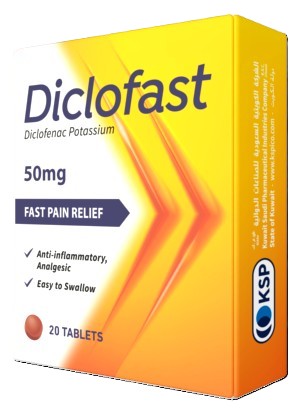Diclofast 50Mg Tablets 20'S
Diclofenac potassium tablets contain the potassium salt of diclofenac, a nonsteroidal compound with pronounced and clinically demonstrable analgesic, anti-inflammatory and anti-pyretic properties. Diclofenac is a potent inhibitor of prostaglandin biosynthesis and modulator of arachidonic acid release and uptake. Diclofenac potassium tablets have a rapid onset of action and are therefore suitable for the treatment of acute episodes of pain and inflammation.
Indications:
• Rheumatoid arthritis
• Osteoarthrosis
• Low back pain
• Migraine attacks
• Acute musculoskeletal disorders and trauma such as periarthritis (especially frozen shoulder), tendinitis, tenosynovitis, bursitis, sprains, strains and dislocations; relief of pain in fractures
• Ankylosing spondylitis
• Acute gout
• Control of pain and inflammation in orthopedic, dental and other minor surgery
• Pyrophosphate arthropathy and associated disorders
Posology:
Adults: 100-150 mg in 2-3 divided doses.
• In migraine, an initial dose of 50 mg should be taken at the first signs of an impending attack. In cases where relief 2 hours after the first dose is not sufficient, a further dose of 50 mg may be taken. If needed, further doses of 50 mg may be taken at intervals of 4-6 hours, not exceeding a total dose of 200 mg per day.
Children >14 years: 75-100 mg in 2-3 divided doses.
• The use of Diclofast in migraine attacks has not been established in children.
Precautions:
• For oral administration with fluid, preferably with or after food.
• Used with caution in patients prone to adverse reactions, using the lowest effective dosage in frail elderly patients or those with a low body weight, mild to moderate renal or hepatic impairment.
Contraindications:
• Hypersensitivity to the active substance or any of the excipients.
• Active, or history of peptic ulcer, gastrointestinal bleeding or perforation (≥ episodes).
• Renal or liver failure
• Established congestive heart failure (NYHA II-IV), ischemic heart disease, peripheral arterial disease and/or cerebrovascular disease
• Attacks of asthma, angioedema, urticaria or acute rhinitis are precipitated by ibuprofen, acetylsalicylic acid or other nonsteroidal anti-inflammatory drugs.
• Hereditary fructose intolerance.
• Children <14 years of age.
• Women attempting to conceive
• Pregnancy (last trimester) and breastfeeding
Undesirable effects:
Common adverse events (≥ 1/100, <1/10) include nausea, vomiting, diarrhea, dyspepsia, abdominal pain, flatulence, anorexia, headache, dizziness, vertigo, elevated liver enzymes (Transaminases), and rash.
Pharmacokinetic properties:
• Diclofenac is rapidly and completely absorbed from sugar-coated tablets. Food intake does not affect absorption. Peak plasma concentration after one 50 mg sugar-coated tablet was 3.9 μmol/l after 20-60 minutes. The plasma concentrations show a linear relationship to the size of the dose. Diclofenac undergoes first-pass metabolism and is extensively metabolized.
• Diclofenac is highly bound to plasma proteins (99.7%), chiefly albumin (99.4%). Diclofenac was detected in a low concentration (100 ng/mL) in breast milk in one nursing mother. The estimated amount ingested by an infant consuming breast milk is equivalent to a 0.03 mg/kg/day dose (see section 4.6 Pregnancy and lactation).
• The total systemic clearance of diclofenac in plasma is 263 ± 56 ml/min (mean ± SD). The terminal half-life in plasma is 1-2 hours.
• The biotransformation of diclofenac involves partly glucuronidation of the intact molecule but mainly single and multiple hydroxylation followed by glucuronidation.
Storage and disposal:
• Keep in a safe place, out of reach and sight of children.
• Store below 30° C.
How to use?
Adults: 100-150 mg in 2-3 divided doses.
• In migraine an initial dose of 50 mg should be taken at the first signs of an impending attack. In cases where relief 2 hours after the first dose is not sufficient, a further dose of 50 mg may be taken. If needed, further doses of 50 mg may be taken at intervals of 4-6 hours, not exceeding a total dose of 200 mg per day.
Children >14 years: 75-100 mg in 2-3 divided doses.
• The use of Diclofast in migraine attacks has not been established in children.
| SKU | 149440 |
|---|

